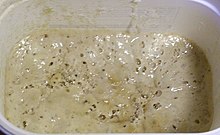Making your own sourdough bread may seem daunting. You might think it takes a lot of work. Or you may have been scared off by the Amish friendship bread that friends have tried to pawn off on, er, bless you with.
But, it's not as hard as you might think. It doesn't take a lot of time to maintain the starter- a few minutes a day. And making the bread takes about an hour. The longest part is waiting for the bread to proof or rise, which can take 4- 24 hours.
A Brief History
Sourdough likely originated in Ancient Egypt around 1500 BC. Sourdough remained the usual form of leavening down into the European Middle ages.
Sourdough was the main bread made in California during the gold rush, and it remains linked to San Francisco today. The bread became so common that "sourdough" became a general nickname for the gold prospectors. A "sourdough" is also a nickname used in the North (Yukon/Alaska) for someone having spent an entire winter north of the Arctic Circle and refers to their tradition of protecting their Sourdough during the coldest months by keeping it close to their body.
In English-speaking countries, where wheat-based breads predominate, sourdough is no longer the standard method for bread leavening. It was gradually replaced, first by the use of barm from beer making, then by cultured yeasts.
San Francisco sourdough is the most famous sourdough bread made in the U.S. today. In contrast to sourdough production in other areas of the country, the San Francisco variety has remained in continuous production since 1849, with some bakeries able to trace their starters back to California's Gold Rush period.
Health Benefits
Traditionally made sourdough bread (meaning no yeast has been added) is a healthy option for many who cannot tolerate store bought bread. Because the active cultures in the starter break down the proteins in the flour, many people who are sensitive to gluten (not Caeliac) have been able to enjoy breads again.
Because of the fermentation process, more of the sugars in the grains are broken down. This makes the breads easier to digest and may also increase the nutrient content (especially B vitamins) of the bread. The process also breaks down some of the anti- nutrients found in grains, especially the phytic acid that binds minerals in your body (thereby eliminating them from your body).
Getting Started
The easiest way to get started making your own sourdough bread is to start with a culture. If you don't have a friend willing to share some of their starter with you, you can purchase a starter through Cultures for Health. I've been using the whole wheat sourdough culture and am loving it. Or you can try to capture the wild yeasts and bacteria in your area (I've done that, and it's not as easy as it might sound)
A sourdough culture contains active cultures, so you need to make sure you use non- reactive equipment. Glass, wood and plastic are good choices.
You will need a container, something to stir it with and a breathable lid. Covering the container with cheesecloth works well.
Making bread, and especially sourdough bread, is a bit of science and a bit of art. You can follow a recipe exactly or you can branch out on your own once you have the basics down. I like this recipe as a good starting point.
A healthy sourdough starter
I could go on and on about sourdough breads and how to make them, but that would make for a very long blog post =) Cultures for Health is one of my favorite places to find information on making sourdoughs. Any internet search will bring up dozens of pages on different recipes and techniques. I would recommend finding one that you like and works for you (and your area) and to experiment with it from there.
This post contains affiliate links that Mom 4ce receives compensation for. This money is used to keep our blog up and running and one day if we ever have excess money from these affiliate links we plan on buying more fitness equipment. We will NEVER post a link for something that we wouldn't use or do use in our own homes.



No comments:
Post a Comment